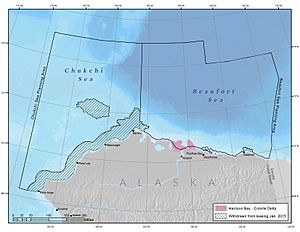Colville Delta facts for kids
The Colville Delta is a special place in northern Alaska. It's where the Colville River meets the ocean, flowing into Harrison Bay. This area is very flat. It's hard to tell where the river stops and the ocean starts! The river brings lots of good stuff, like nutrients, into the water. This makes the delta a super important home for many animals.
Contents
Where is the Colville Delta?
The Colville Delta is in northern Alaska. It's formed by the Colville River. This river is about 350 miles (560 km) long. It starts in the De Long Mountains. The river flows all the way to the village of Nuiqsut. Here, it spreads out and forms the wide delta.
Amazing Animals of the Delta
The waters of the Colville Delta and Harrison Bay are a safe place for many birds. You can find long-tailed ducks, king eiders, and red-throated loons. Other birds include Arctic terns, surf scoters, and brant geese. Glaucous gulls also live here.
Migrating Birds
In summer and fall, many birds stop here to rest and eat. These include red-throated and yellow-billed loons. King and spectacled eiders also visit. They are on their long journeys.
Fish and Food Webs
Small fish near the shore are very important. They are called forage fish. They help connect tiny sea creatures to bigger animals. These fish are a key part of the Arctic food web. Harrison Bay is a great home for fish like Arctic cod and capelin.
Polar Bears
In winter, polar bears come to the delta. They hunt and eat seals on the ice. They look for seals on the frozen shore. They also find them near open cracks in the ice. Pregnant polar bears often build their dens here. They stay in these dens during the winter.
Other Fish Species
The Colville River used to have a small fishing industry. People caught Arctic ciscoes there. Even though that fishery is closed, the delta is still a good home for fish. You might find Salmonidae fishes like broad whitefish. Nearshore forage fishes like Arctic cod and capelin also live here.


